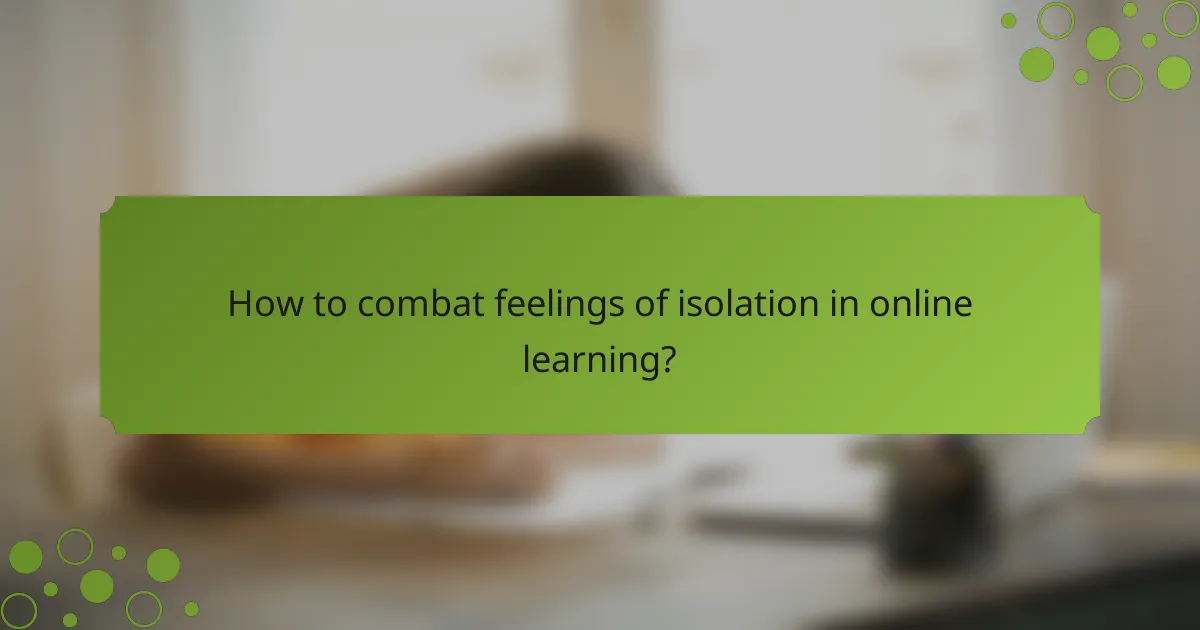Self-paced courses offer flexibility but require strong self-discipline to navigate potential pitfalls like procrastination and isolation. By establishing clear goals and a structured schedule, learners can enhance their focus and productivity. Additionally, fostering connections with peers and instructors can help create a supportive community, making the learning journey more engaging and less solitary.

How to overcome self-discipline challenges in self-paced courses?
To overcome self-discipline challenges in self-paced courses, it’s essential to implement strategies that foster motivation and accountability. By setting clear goals, creating a structured schedule, and utilizing support systems, learners can effectively combat procrastination and feelings of isolation.
Set clear goals
Establishing clear and achievable goals is crucial for maintaining focus in a self-paced course. Break down larger objectives into smaller, manageable tasks, which can help track progress and provide a sense of accomplishment. For instance, instead of aiming to complete an entire module, set a goal to finish a specific lesson each day.
Use the SMART criteria—Specific, Measurable, Achievable, Relevant, Time-bound—to ensure your goals are well-defined. This method helps clarify what you want to achieve and when, making it easier to stay disciplined.
Create a structured schedule
A structured schedule can significantly enhance self-discipline in self-paced learning. Allocate specific times each week dedicated to studying, just as you would for a traditional class. Consistency is key; try to stick to the same days and times to build a routine.
Consider using digital calendars or planning apps to set reminders and keep track of deadlines. This visual representation of your study plan can help you stay organized and committed to your learning objectives.
Utilize accountability partners
Having an accountability partner can greatly improve your self-discipline in a self-paced course. This could be a friend, family member, or fellow student who shares similar goals. Regular check-ins can motivate you to stay on track and provide support during challenging times.
Set up a schedule for these check-ins, whether weekly or bi-weekly, to discuss progress and challenges. This mutual support can help reduce feelings of isolation and encourage a more disciplined approach to learning.
Incorporate rewards
Incorporating rewards for achieving milestones can enhance motivation and self-discipline. Set up a system where you treat yourself after completing a significant task or reaching a goal. This could be as simple as enjoying a favorite snack, taking a break to watch a show, or spending time on a hobby.
Make sure the rewards are proportional to the effort put in; smaller tasks can have smaller rewards, while larger accomplishments deserve more significant incentives. This positive reinforcement can help maintain your focus and drive.
Limit distractions
Limiting distractions is essential for maintaining self-discipline in self-paced courses. Identify what commonly distracts you—social media, television, or noisy environments—and take steps to minimize these interruptions. For example, consider using website blockers during study sessions or finding a quiet space to work.
Establishing a dedicated study area can signal to your brain that it’s time to focus. Keep this space organized and free of clutter to enhance concentration and productivity.

What strategies help prevent procrastination?
To prevent procrastination, it is essential to implement effective strategies that enhance focus and productivity. These strategies can help maintain motivation and create a structured approach to completing tasks.
Break tasks into smaller steps
Breaking tasks into smaller, manageable steps can significantly reduce feelings of overwhelm and make it easier to start. For example, instead of tackling an entire project at once, outline the project into specific tasks such as research, drafting, and editing.
By focusing on one small step at a time, you can create a sense of accomplishment that fuels further progress. Set clear deadlines for each step to maintain momentum and avoid falling back into procrastination.
Use time management techniques
Effective time management techniques can help structure your day and prioritize tasks. Consider using methods like the Eisenhower Matrix, which categorizes tasks based on urgency and importance, allowing you to focus on what truly matters.
Additionally, creating a daily or weekly schedule can help allocate specific time blocks for each task, making it easier to stay on track. Remember to include breaks to recharge and maintain productivity throughout the day.
Implement the Pomodoro Technique
The Pomodoro Technique involves working in focused bursts, typically 25 minutes long, followed by a short break. This method can enhance concentration and reduce the likelihood of distractions, making it easier to complete tasks efficiently.
After four Pomodoros, take a longer break of 15-30 minutes to rest and reset your mind. This structured approach can help maintain high levels of productivity while preventing burnout.
Establish a dedicated study space
Creating a dedicated study space can significantly improve focus and minimize distractions. Choose a quiet area that is free from interruptions and equipped with all necessary materials, such as a computer, books, and stationery.
Personalize your study space to make it inviting and comfortable, but avoid clutter that can lead to distractions. Consistently using this space for study can condition your mind to associate it with productivity, further enhancing your ability to concentrate and reduce procrastination.

How to combat feelings of isolation in online learning?
To combat feelings of isolation in online learning, actively seek out connections with peers and instructors. Engaging with others can create a sense of community and support, making the learning experience more enjoyable and less lonely.
Join online study groups
Joining online study groups can provide a structured way to connect with fellow learners. These groups often meet regularly to discuss course materials, share resources, and motivate each other. Look for platforms like Zoom or Discord where you can easily set up a group.
Consider forming a study group with classmates or joining existing ones through your course platform. Aim for groups of 4-8 people to maintain a balance between interaction and manageability.
Participate in discussion forums
Discussion forums are an excellent way to engage with a broader community of learners. Contributing to threads or starting new discussions allows you to share insights and ask questions, fostering a sense of belonging. Platforms like Reddit or specialized course forums can be useful.
Make it a habit to check forums regularly and respond to at least one post daily. This consistent engagement can help you feel more connected to your peers and the course content.
Engage with instructors
Directly engaging with instructors can enhance your learning experience and reduce feelings of isolation. Don’t hesitate to ask questions during live sessions or send emails for clarification on topics. Most instructors appreciate proactive students and are willing to help.
Consider scheduling virtual office hours if available. This one-on-one interaction can provide personalized guidance and strengthen your connection to the course.
Attend virtual networking events
Virtual networking events offer opportunities to meet other learners and professionals in your field. These events can range from informal meetups to structured webinars, providing a platform to exchange ideas and build relationships. Look for events hosted by your institution or relevant organizations.
Set a goal to attend at least one networking event per month. Prepare by researching attendees or topics in advance to make meaningful connections during the event.

What are the prerequisites for succeeding in self-paced courses?
To succeed in self-paced courses, learners need a strong sense of self-discipline, effective time management skills, and access to the necessary technology. These factors help mitigate potential procrastination and feelings of isolation that can arise in a self-directed learning environment.
Self-motivation
Self-motivation is crucial for thriving in self-paced courses, as learners must drive their own progress without external prompts. Setting personal goals and tracking progress can enhance motivation. Consider using a reward system for achieving milestones to maintain enthusiasm.
Common pitfalls include losing interest or becoming distracted. To combat this, establish a routine that incorporates study sessions into your daily life, making learning a consistent priority.
Basic time management skills
Effective time management is essential for balancing coursework with other responsibilities. Create a study schedule that allocates specific times for learning, ensuring that you dedicate enough hours each week to stay on track. A common approach is the Pomodoro Technique, which involves studying for 25 minutes followed by a 5-minute break.
Be mindful of deadlines and plan ahead to avoid last-minute cramming. Using digital calendars or task management apps can help keep you organized and accountable for your study commitments.
Access to necessary technology
Having reliable access to technology is fundamental for engaging in self-paced courses. This includes a computer or tablet, a stable internet connection, and any required software or applications. Ensure your devices are updated and capable of running the course materials smoothly.
Consider the potential costs associated with technology, such as subscription fees for software or high-speed internet plans. If budget constraints exist, explore community resources like libraries or local organizations that may offer access to necessary tools.

How to evaluate the effectiveness of self-paced courses?
To evaluate the effectiveness of self-paced courses, consider factors such as course completion rates, learner engagement, and the achievement of learning objectives. Assessing these elements helps determine if the course meets its intended goals and provides value to participants.
Self-discipline required
Self-paced courses demand a high level of self-discipline from learners. Without a structured schedule, individuals must manage their time effectively to stay on track and complete the coursework. This requires setting personal deadlines and creating a study plan that aligns with their learning goals.
To enhance self-discipline, learners can establish a routine that includes dedicated study periods. Utilizing tools like calendars or task management apps can help keep track of progress and deadlines. Regularly reviewing goals and adjusting plans as needed can also foster accountability.
Potential procrastination
Procrastination is a common challenge in self-paced learning environments. The absence of external deadlines can lead to delays in course completion, which may hinder overall learning outcomes. Recognizing the signs of procrastination is crucial for addressing it effectively.
To combat procrastination, learners should break tasks into smaller, manageable segments. Setting specific, achievable goals for each study session can create a sense of accomplishment and motivate continued progress. Additionally, finding a study buddy or joining an online community can provide support and encouragement.
Isolation
Isolation can be a significant drawback of self-paced courses, as learners may miss out on the collaborative aspects of traditional classroom settings. This lack of interaction can lead to feelings of loneliness and decreased motivation. Engaging with peers can enhance the learning experience and provide valuable feedback.
To mitigate isolation, learners should seek opportunities for interaction, such as participating in online forums, attending virtual study groups, or connecting with instructors during office hours. Building a network of fellow learners can foster a sense of community and enhance accountability, making the self-paced learning journey more enjoyable and effective.



